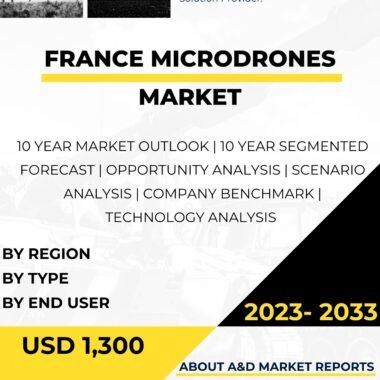Description
The Saudi Arabia Microdrones Market is an emerging and rapidly growing segment within the country’s defense and commercial industries. Microdrones, also known as small unmanned aerial systems (sUAS) or drones, are unmanned aerial vehicles (UAVs) with a compact size and lightweight design. As a key player in the Middle East region, Saudi Arabia recognizes the strategic importance of adopting cutting-edge technology like microdrones to enhance its military capabilities, support critical infrastructure, and contribute to economic development.
The Saudi Arabia Microdrones Market is characterized by a mix of international and domestic companies that specialize in microdrone development and manufacturing. International UAV manufacturers, such as DJI, Parrot, and AeroVironment, have a significant presence in the market and offer a wide range of microdrone solutions.
One of the primary drivers of the Saudi Arabia Microdrones Market is the Royal Saudi Air Force’s (RSAF) commitment to modernizing its fleet of military aircraft and adopting advanced technology for surveillance and reconnaissance missions. Microdrones provide the RSAF with a cost-effective and flexible tool for conducting intelligence, surveillance, and reconnaissance (ISR) operations, as well as supporting precision strikes when equipped with munitions.
Moreover, the RSAF’s involvement in regional conflicts and international military operations underscores the importance of microdrones. These UAVs offer the RSAF the advantage of rapid deployment and intelligence gathering, enabling them to respond quickly to emerging threats and conduct precise and targeted operations.
Beyond the defense sector, the Saudi Arabia Microdrones Market also has significant potential in commercial applications. Industries such as agriculture, oil and gas, construction, and infrastructure inspection are increasingly adopting microdrones for tasks like crop monitoring, pipeline inspection, aerial mapping, and surveillance.
The Saudi government’s Vision 2030 economic diversification plan also influences the Microdrones Market. As part of this vision, Saudi Arabia aims to develop a robust domestic technology sector capable of contributing significantly to the national economy. This includes fostering partnerships and joint ventures with international UAV companies for technology transfer and knowledge sharing.
Localization of microdrone manufacturing aligns with the broader goal of creating high-skilled job opportunities for Saudi citizens and promoting research and development within the country.
The RSAF’s focus on modernizing its UAV capabilities involves exploring the acquisition and development of advanced microdrones. These systems are equipped with state-of-the-art sensors, communication systems, and data links to ensure real-time data transmission and mission success.
The effective integration of microdrones into the RSAF’s existing defense infrastructure demands careful planning and coordination. Ensuring interoperability with other military systems, providing comprehensive training for operators, and adhering to regulatory requirements for UAV operations are essential for maximizing the microdrones’ utility and effectiveness.
Similarly, in the commercial sector, the successful integration of microdrones into various industries requires adherence to aviation regulations, training of operators, and effective data management to leverage the full potential of microdrone technology.
However, the Saudi Arabia Microdrones Market also faces challenges. Developing and acquiring advanced microdrones requires substantial financial investment and continuous research and development efforts to stay at the forefront of technological advancements. The RSAF and commercial users must balance operational requirements with budget constraints to ensure the acquisition of cost-effective and cutting-edge microdrone systems.
Moreover, the rapid adoption of microdrones in the commercial sector also raises concerns related to safety, privacy, and airspace management. Striking the right balance between reaping the benefits of microdrone technology and ensuring public safety and privacy is essential for sustainable growth in this market.
In conclusion, the Saudi Arabia Microdrones Market is an exciting and evolving segment with significant potential in both defense and commercial applications. As the RSAF continues to modernize its military capabilities and adopt advanced technology for ISR missions, the demand for microdrones is expected to grow.
International UAV manufacturers with expertise in microdrone development and manufacturing will continue to play a significant role in this market. However, the Saudi government’s focus on economic diversification and indigenous technology development will drive increased collaboration and technology transfer initiatives.
By fostering local research and development, training programs, and investments in microdrone technology and infrastructure, Saudi Arabia aims to build a robust and self-sufficient UAV sector, ensuring the RSAF remains operationally effective and prepared to meet future challenges.
Additionally, the growth of the commercial sector will continue to create opportunities for local businesses and entrepreneurs to develop innovative solutions and services using microdrones, contributing to economic growth and technological advancement in the Kingdom.
As the Kingdom seeks to maintain regional stability, enhance national security, and promote economic development, the Microdrones Market will remain a critical area of focus within the broader defense and technology modernization efforts.




